It’s a delicious fakeout. Nobody had seen a big budget movie based on a comic book before, and didn’t know what to expect. So when the movie opens with a little boy reading aloud from a comic book, it looks like all of your worst fears have come true.

The opening moments of Superman: The Movie are aggressively old-timey. There’s a faraway John Williams trumpet lick, and then a monochrome stage curtain rattles open to reveal a dark theater screen of ancient aspect ratio. A film projector cranks itself to life, whirring noisily as it projects the legend “JUNE 1938” on the screen. Someone is attempting to make a point.

Fade up on a black-and-white bedspread, displaying a comic book with a bold cover illustration of a pair of Art Deco spaceships hurtling away from some disintegrating solar system. The suggestion is that this is the first issue of National Periodical’s anthology Action Comics, which debuted with a cover date of June 1938. It isn’t, really; the actual first issue’s cover showed a guy in a circus outfit picking up an automobile and smacking people around with it.

“In the decade of the 1930s,” the kid reads aloud from an unlikely page-one splash panel, “even the great city of Metropolis was not spared the ravages of the world-wide depression!” Nobody said that it was. “In a time of fear and confusion, the job of informing the public was the responsibility of the Daily Planet: the great metropolitan newspaper whose reputation for clarity and truth had become a symbol of hope for the city of Metropolis!”
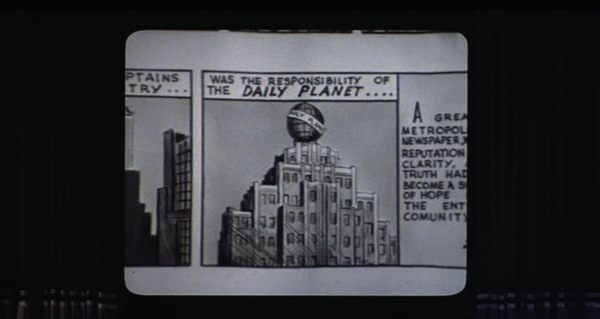
Except that it wasn’t, in June 1938. The newspaper that Clark Kent works for in Action Comics #1 is called the Daily Star, and as we learn in issue #2 (where it’s called the Evening News), it’s located in Cleveland.
But that doesn’t matter, obviously, because this movie isn’t based on the Action Comics of June 1938, or of ’78, for that matter, when Clark was working as a TV news anchor. Superman: The Movie isn’t actually an adaptation of Action Comics at all. It’s an adaptation of “Superman”, which is the thing that you think of when somebody says the word Superman.
The cultural mix of characters, names, images, story tropes and much-spoofed cliches that we think of collectively as “Superman” was not actually authored by anyone in particular. Yes, Jerry Siegel and Joe Shuster ignited the spark in Action Comics #1, and there are elements in those first stories that turned out to be timeless, but the concept of Superman that you know in your heart was constructed over several decades by multiple simultaneous teams of creative and business people, in active collaboration with everybody else in the world.
I mean, yeah, somebody wrote scripts and drew pictures and hired actors and negotiated merchandising contracts, but the real editors-in-chief were you and me: the people who bought the comic, and read the newspaper strip, and watched and listened to and purchased and parodied the versions that we found most memorable and compelling, all of them overlapping and contradicting each other, until we came to a general shared understanding that we could all live with.
There’s a good chunk of the radio show in there, and some concepts that were first tried out in the comic strip. To construct the cultural concept of “Superman”, we took some of the most memorable images from the Fleischer cartoons, and when the ’50s TV show was on the air, we all pitched in to trim the radio cast down to its main essentials. Some of the “Superman” concepts that we know originated in a 1942 hardcover novel which pretty much nobody’s read for decades. There’s even a bit of Mighty Mouse in there, if you look close enough.
In fact, the cultural conception of “Superman” didn’t really pull together until December 1978, when everybody went to see Superman: The Movie. As soon as it premiered, this movie instantly became the agreed-upon version of “Superman” that everyone still thinks of as the genuine article. When there’s a new movie or TV show, nobody compares it to the 1940s radio show, or the 2006 Superman Returns. The relevant comparison is Christopher Reeve and Margot Kidder. Superman: The Movie may be the only film ever made that’s actually an adaptation of itself.
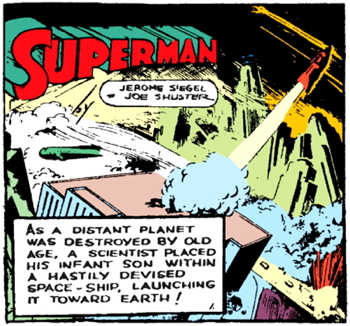
But sure, since they brought it up, we might as well start here: June 1938.
The origin story on page 1 of Action Comics #1 lasts for four panels and offers no details. The planet isn’t called Krypton yet, and halfway through the first sentence, it’s already gone. “As a distant planet was destroyed by old age,” the caption says, “a scientist placed his infant son within a hastily devised space-ship, launching it toward Earth!”
And that’s it, no explanation — just a nameless planet that died of a broken heart. Now, that’s what I call a world-wide depression; those people in 1938 Metropolis must be a bunch of crybabies.

The next thing you know, we’re on Earth, in the care of a passing motorist. There’s no farm family for ’38 Superman, just one panel of a showboating baby wowing the crowd at a standing-room-only orphanage. Apparently the kid’s physical structure is millions of years advanced of our own, whatever that means, and he is living that life.
“Hey toots,” he’s clearly saying, “grab an eyeful of this. What what!” Kid knows how to party.

And then, faster than an express train, he’s reached maturity, and he’s not looking back. Raised by an exploding scientist and a passing motorist, he has barely touched the ground and has no plans to settle down. Here in 1978, we’re about to get hit with forty-six minutes of tragic backstory including two fathers dying within twelve minutes of each other, but 1938 Clark was born to run. The past is a distant planet destroyed by old age; by panel four, Clark is all grown up, and heading for a Midwest city to start a new career in journalism, like Mary Tyler Moore. Next stop: Cleveland.

We catch up with him on page 2 in a tremendous rush, carrying a blonde lady in a revealing dress, who’s been bound and gagged for some reason. He’s leaping across the countryside, because at this point all he can do is jump an eighth of a mile at a time; Superman can’t fly yet, and nobody asks him to. He’ll have to wait for the radio show in 1940 to really get airborne, and he doesn’t fly in the comics until 1943.
Still, it’s not everybody who can race through the night across enemy territory to reach the governor’s mansion, carrying a full-grown human lady who looks like nothing but dead weight from here. He dumps her on the lawn and tells her to make herself comfortable; apparently this is his new contactless lady delivery service.

Breaking down the front door with reckless disregard for good manners and architecture, the costumed figure makes his way up the stairs, tossing a butler over his head as he squeals for mercy. This must be why we don’t hear about that orphanage very much; it must be a mass of sawdust and splinters by now.

Upstairs in the hallway, the servant gloats, “Yes, this is the governor’s sleeping room — don’t think you’re going to get away with this outrage!” Superman finds that the door is locked, and the butler crows, “Yes! And made of steel! Try and knock this door down!”
It’s left to the reader to imagine why the governor of probably Ohio sleeps behind a steel vault door like his bedroom is Scrooge McDuck’s money bin, but it doesn’t matter; the titanic intruder makes short work of the security system, and enters the presence.

“Evelyn Curry is to be electrocuted in 15 minutes for murder,” our hero tells Governor Rich Uncle Pennybags, “I have proof here of her innocence — a signed confession!” Apparently this is a murder investigation, conducted at lightning speed with no time to explain anything to the paying customers.

It’s the bottom of the page and Superman hasn’t done anything super for a couple of panels, so the butler produces a concealed weapon from his green bathrobe and plugs away at the man of steel. Butlers were ready for anything back then; he also knows jiu jitsu if he needs a fallback.
The bullets ricochet off Superman’s tough skin — “this is no time for horseplay!” he scolds as he disarms the help — and he delivers the documents to the governor in time to get a last-minute pardon for poor Evelyn C.
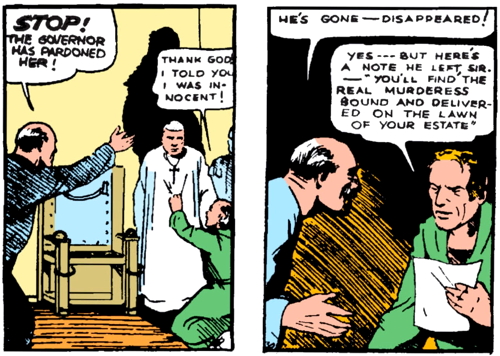
“He’s gone — disappeared!” says the rattled governor, and the butler agrees, “Yes — but here’s a note he left, sir — ‘You’ll find the real murderess bound and delivered on the lawn of your estate.'” I don’t know why Superman had to write that down rather than just say it on his way out the door, but what do I know? My physical structure is a million years less advanced than his; at this point I’ll probably never catch up. I hope he’s going out through the same door that he came in; this is getting expensive. The governor isn’t made of doors.

“Gentlemen, I still can’t believe my senses,” the governor informs the science council. “He’s not human! — Thank heaven he’s apparently on the side of law and order!” And that is it, as far as the Evelyn Curry mystery is concerned; done and dusted in three pages, and the world moves on. This is the way that Superman behaves.
The pacing in this first issue is all over the place, because Siegel and Shuster didn’t know that they were making a comic book at the time; they thought that they were pitching a daily newspaper comic strip. All the big syndicates turned them down, calling their work immature and too much like science-fiction. Then National Publications offered them a spot in the first issue of Action Comics, and Siegel and Shuster quickly pasted up their existing work to fit a 13-page comic book story.
So what we’ve got in this first issue is an introduction page, followed by three short stories of varying length and the beginning of a fourth, which stops abruptly after four pages and continues in the next issue.

On page 5, Siegel and Shuster introduce the basic template that they’ll use again and again: Clark walks into the editor’s office, and the editor gives him an assignment that requires the attention of both reporter Clark Kent and a dangerous space monster called Superman.
The editor doesn’t have a name right now, and he doesn’t need one. He’s not a character; he’s a narrative function. The chief is here to give Clark a place to start, and then point in the direction of the door and tell him to get going. Once the story’s over, Clark reports back to the paper for a final panel or two, where the editor congratulates him on another great story, end of adventure.
In the first twelve months of the comic, there are six issues that work according to that template, with Clark going out on newspaper missions. In the other half, Superman just shows up somewhere, gets pissed off about something and starts hitting dudes.
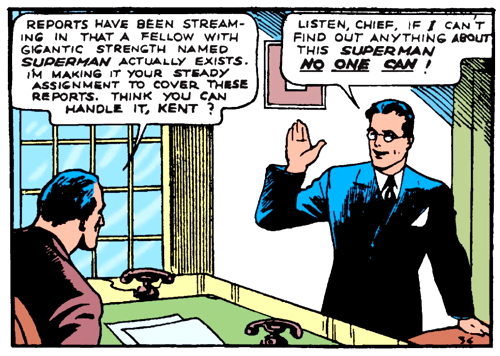
This meet-and-greet is also where we get the first glimpse of the Clark/Superman dual identity, a narrative concept so productive that here we are more than 80 years later, and people are still writing stories about it.
Siegel and Shuster put the irony right up front, with the editor asking Clark to cover the reports of a strange new Superman who’s appeared around town. “Listen, chief,” Clark grins, “if I can’t find out anything about this Superman, NO ONE CAN!”
This is one of those little audience-appreciation moments, like Dracula telling his dinner guest “I never drink… wine.” The character is making a joke that within the story only he understands, but the readers are in on the secret too, which is pleasurable and makes us like the character more.
As a rule, there are three steps to getting the audience to like a character and want to spend time with them: make a friend, make a joke, and make something happen. Having a friend grounds the character and demonstrates that they have worth in the narrative, the joke indicates that the character understands it’s their job to entertain the audience, and the plot point moves the story forward, which is what we really want.

And we get it two panels later, when Clark gets a tip about a wife-beating and shows up on the scene as an unstoppable force of vengeance, picking up the violent husband and hurling him against the wall so hard that the apartment may never fully recover.

The battered husband loses consciousness right next to his battered wife, which allows for the first inexplicable costume change. “Hearing police-sirens,” the narration informs us, “Superman hurriedly dons street-clothes over his uniform.” What dimension these street-clothes apparate from is not shared with us, and the audience is not expected to notice or care.
I mean, I suppose that Clark could have stashed the clothes right before bursting through yet another of the many doomed doors that he regularly encounters, but that means that there was a suit jacket and a pair of glasses just lying on the floor in the hallway, while Superman was tearing it up with the wife-beater. But we’re not supposed to think about it; it’s just a magic power that makes the plot point work.
Decades later, the comics writers came up with an explanation for this — he’s got special “compressible clothes” that Superman balls up into a little wad, and then shoves into a hidden pocket in his cape — but that idea is embarrassing and depressing, and I don’t want to talk about it anymore.
Anyway, while we’ve been chatting, the police have arrived, and Clark claims that he’s not responsible for all the destruction. It looks like “our friend Superman” stopped by, he says, measuring out fistfuls of swift and terrible vigilante justice. They don’t specify what happens to this bruised and broken family unit after that, but it doesn’t matter. Superman saved the day, somehow. Problem solved.

And then, having established that Clark is secretly the best at everything, Siegel and Shuster give him the one thing that he eternally fails at: going on a date with Lois Lane, a reporter currently installed as the Daily Star’s sob sister but destined for greater things.
It’s not clear, within the story, what Clark thinks that he’s going to get out of a date with a strong-willed reporter who despises him on sight. He’s got an enormous, dangerous secret concealed just below his necktie, and you’d imagine that he’d want to direct people’s attention away from himself. But he’s lonely, I guess, and it’s hard to resist Lois’ charm.
In her first panel, Clark stammers out an invitation, and she eyes him icily and cracks, “I suppose I’ll give you a break… for a change.”
Suddenly, they’re on the dance floor, and Clark asks, “Why is it you always avoid me at the office?” She looks away. “Please, Clark! I’ve been scribbling ‘sob stories’ all day long. Don’t ask me to dish out another.”
Those are the jokes, by the way, the ones that make us like her. They’re not laugh lines, but if you compare them to the way that humans actually talk, you can see how heightened and screwball-comedy cutting they are. Clark is the friend, those are the jokes, and here comes the plot point; Lois scores a triple crown in five panels.

Action Comics likes to have at least one outburst of sudden violence per page, and this time it’s Lois’ turn, smacking a muscleman who’s trying to muscle in on their date. She’s the only other combatant in this 13-page battle royale who’s allowed to get in the ring and throw a punch without calling down lightning from the gods; that’s how important she is.

Naturally, this riles up the dance-floor reject, who happens to be the leader of a gang of hoodlums. “I’ll show that skirt she can’t make a fool out of Butch Mason!” the riled hoodlum says, and before you know it, they’ve created a road accident in order to abduct Lois and drive away with her. This is what happens when you try to arrange quiet dinner dates in the pages of Action Comics.

Once we’ve all agreed that we like Lois, then everything else falls into place; this is the excuse for Clark Kent’s lunatic behavior that we needed.
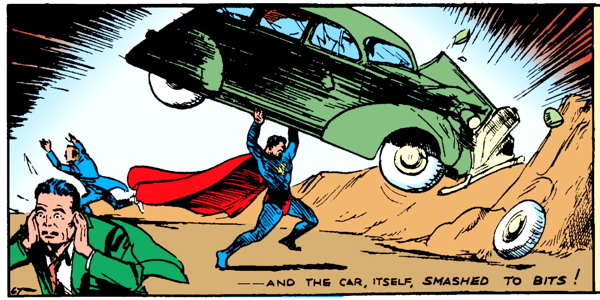
I mean, he’s psychotic, obviously. You can’t look at what he does over the course of 13 pages, and see anything other than a power-mad cuckoo from outer space, dealing out chaos and carnage wherever he goes. The governor may think that this monster is on the side of law and order, but so far all I’ve seen is a man who delivers beatings to innocent butlers and Studebakers. He operates entirely on impulse, charging in and doing whatever the hell he wants. Law, maybe, but definitely not order.
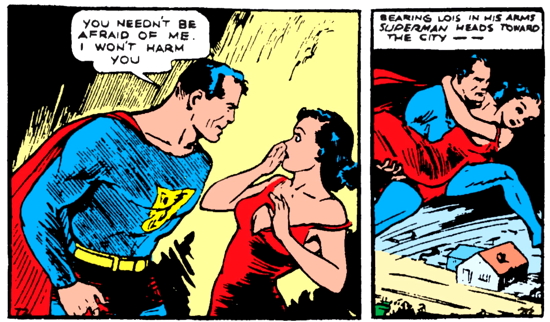
The only thing you can say in his favor, really, is that he helps out women who are in trouble. He saves Evelyn Curry just before her execution; he hospitalizes the beaten wife’s oppressor, and he rescues Lois from being trafficked. That’s what Superman does: he helps women. Admittedly, he tends to treat them more like cargo than anything else, but his heart appears to be in the right place, assuming he has one.

So this is the Superman of June 1938, this reckless jokester who — if you get on his bad side — is liable to beat you to death with your own car. It seems impossible that somebody would be able to keep this erratic story thundering on for another 1,000 issues, but they managed it somehow, and now we’re watching a movie about it.
So that, as they say, is how it started. Let’s get back to the 1970s, and see how it’s going.
Tomorrow:
We meet the villains of the story,
Alexander and Ilya Salkind…
1.2: It Was Ilya’s Idea

— Danny Horn

This is terrific! I hope you post at least as many entries here as you did on DSED.
LikeLiked by 2 people
Excellent! I am only a casual fan of Superman, having seen all the movies about him since Christopher Reeves first donned the cape. I was a HUGE fan of the TV series “Lois and Clark”.
I really appreciate your sharing the panels from the original comic book. I’ve never seen that and wasn’t aware that Superman could only leap large at first.
Looking forward to your insight and commentary on these super hero movies.
LikeLiked by 1 person
I followed Dark Shadows Every Day closely, so I’m very glad to see this.
LikeLiked by 2 people
So original Lois seems like a “tough cookie”. She still needs to be rescued by Superman, though. My introduction to the character was the 1950s tv series. That Lois seemed to be much more demure, though that impression may be due to faulty memory.
Part of the charm of Superman for kids, I think, is the same as the fascination with dinosaurs. Big, powerful, destructive things seem to be appealing.
LikeLiked by 1 person
That Lois was played by Noel Neill, among others, who starred as a young actor in a series of films called “The Teen-Agers.” She plays Betty, the editor of the Town Crier, and is an adorable bookworm and intellectual right out of the gate. You can see why she was cast as Lois.
LikeLike
Interesting. I’ll have to see if I can find one of the films. Thanks!
LikeLiked by 1 person
Which Lois? There were two actresses.
LikeLike
The second Lois, Noel Neill.
LikeLike
Outstanding! Glad you’re back and with such a clearly inexhaustible supply of material.
LikeLiked by 2 people
Yeah, Dark Shadows Every Day came with a clear endpoint. This one might take a while.
LikeLiked by 2 people
I love any post that features a picture of The Guy Freaking Out When Superman Lifts a Car.
It will probably not surprise you to learn that I’ve read many thousands of blog posts about Action Comics #1, but this is the first time I’ve seen such thoughtful analysis of the governor’s butler.
LikeLiked by 1 person
Give S&S credit: the scene shown on the cover of the comic book actually appears inside. This will become increasingly rare as the medium evolves.
I’d forgotten what a wise-ass punk he was in the early days.
LikeLiked by 1 person
From Dark Shadows to Superman makes a natural segue. Alex Stevens is in both.
LikeLiked by 2 people
As I understand it, they made him because it looked stupid in the Fleishman cartoons.
LikeLike
Dooh! I should have written “they made him fly because jumping looked stupid in the Fleishman cartoons.
LikeLike
Well, *I* compare new Superman movies and TV shows to the 1940s radio show, but then I always do that when radio is involved in any way.
LikeLike
“They don’t specify what happens to this bruised and broken family unit after that”
Actually they do… but not until 1992. They retell the story of Superman beating up the husband and go on to reveal that the poor wife took this as an opportunity to walk out on the husband. Unfortunately the husband caught her and shot her. Not exactly a happy ending.
The point of the story being that it taught the novice Clark that just rushing in with violence and flying off doesn’t automatically solve problems.
LikeLike
I too followed Dark Shadows Every Day. Mrs. C & I are still trying to finish that series. But that’s not important right now.
Wow, superhero movies as told by Danny Strong! And I get to play along at home this time!! Everyone within the sound of my voice, you must clear your calendar and buckle up for this joyride through pop culture!
LikeLike
Listen, it’s not even reason why. But because Superman The Movie lacks THE main reason why guy has split identities. People will fear guy with that much of a strenght. Even before Shuster started drawing Superman Siegel already had basic concept. That a couple finds alien (but not from another planet, yet, but from future Earth) and decide to raise him as their own. Then he uses his powers in public and father teaches him that he should hide them or he will scare people.
So far only Man of Steel (2013) actually adapted THAT part. And just a little bit Last Son of Krypton Part II, but just a little bit and very toned down concept of it. That first time people will FEAR Superman, even Lois. Like being legitimately scared.
Which is pretty realistic notion if you ask Me. Not to mention absolutely reasonable and logical.
First comics also shown police and military realistically shoot at Superman. Which was only really replicated in Action Comis 2011 a little bit, and in Secret Origins 2010, but there he was actively Fighting miltary (of his own country, I am not sure they really settled what kind of country Superman was in in the first comics it could be as USA as it could be Canada) which wasn’t the case, orginal Superman only ran away from them because they are (supposedly) good guy , just scared ones.
In general Superman The Movie is romance first, comedy second , just the one starring Superman. It is love letter both to the character and His love for the humanity. But it’s not adaptation of comics, not really, just skeleton of it. Which is a way too, in fact most of other comics adaptations aren’t really comics adaptations but their own movies, featuring characters.
LikeLike